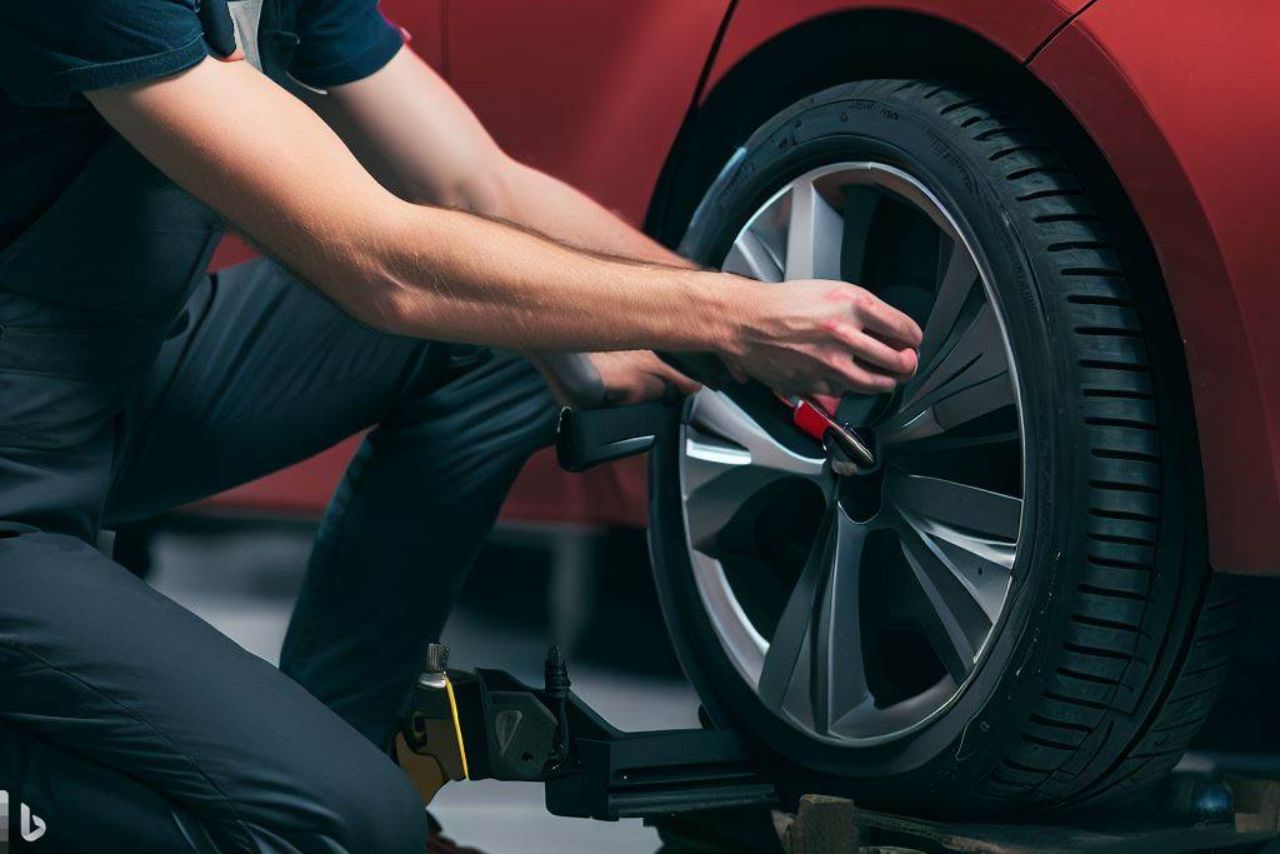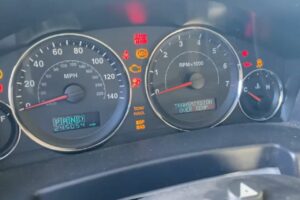Maintaining the correct tyre pressure is an essential aspect of ensuring optimal performance, safety, and fuel efficiency of your Peugeot 208.
Tyre pressure affects several aspects of a vehicle, including its handling, braking, and fuel economy.
In this article, we will discuss the importance of regular tyre pressure checks and provide a comprehensive guide for determining the correct Peugeot 208 Tyre Pressures.
In addition to discussing tyre pressures, we will cover other critical tyre information, such as legal tread limits, tyre brands, and the impact of tyres on grip and traction.
As a Peugeot 208 owner, it is essential to understand the significance of these factors and how they affect your vehicle’s overall performance.
Whether you are a new owner or a seasoned driver, this article provides essential information on tyre pressures that will help you maintain your vehicle’s optimal performance and safety.
Table of contents
Importance of Your Tire Pressure:
Maintaining correct tyre pressures is crucial for Peugeot 208 owners, as failure to do so can result in a range of negative consequences.
One of the benefits of regular tyre pressure checks is safety, as underinflated tyres can compromise grip and handling, particularly in wet conditions.
Additionally, incorrectly inflated tyres can reduce fuel efficiency, leading to increased costs over time.
Furthermore, uneven wear can occur, which can have a significant impact on tyre longevity and performance. To ensure optimal performance and safety, regular tyre pressure maintenance is essential.
Checking tyre pressure at least once per month and before long journeys is recommended.
This allows owners to identify and address any potential issues early on, reducing the risk of more significant problems arising.
Moreover, ensuring that tyres across an axle have the same PSI can help to maintain even wear and consistent performance.
By prioritizing regular tyre pressure maintenance, Peugeot 208 owners can optimize their vehicle’s safety, efficiency, and longevity.
Guide for Correct Peugeot 208 Tyre Pressures:
| Tyre Size | Front | Front (Loaded) | Rear | Rear (Loaded) |
|---|---|---|---|---|
| 185/65 R15 | 32 psi | 32 psi | 29 psi | 33 psi |
| 195/55 R16 | 33 psi | 33 psi | 30 psi | 34 psi |
| 205/45 R17 | 34 psi | 34 psi | 31 psi | 35 psi |
Ensuring that the correct pressure is maintained in your vehicle’s tyres is crucial for optimum performance, safety, and fuel efficiency.
To determine the correct PSI calculation, it is important to refer to the information card in the car, which takes precedence over any other guide.
The correct tyre pressure is determined by the wheel size, width, and sidewall height, and it is important to check it regularly, at least once per month, and before long journeys.
Tyres that are underinflated or overinflated can cause uneven wear, poor fuel economy, increased braking distance, and affect the overall performance of the vehicle.
It is also important to consider the impact of temperature on tyre pressure. As the temperature changes, the pressure in the tyres can fluctuate, and it is important to adjust the pressure accordingly.
Tyre pressure maintenance is essential to ensure that the tyres are performing at their best and to extend their lifespan.
Tyres tend to crack and perish after a period of time, and regular maintenance can help to identify any issues before they become problematic.
Tyre pressure monitoring systems are becoming increasingly common in modern vehicles, which can help to alert drivers to any changes in pressure.
By following these guidelines, drivers can ensure that their vehicle’s tyres are performing at their best and are safe to drive on.
Peugeot 208 Tyre Pressures:
To achieve optimal vehicle performance and ensure safety on the road, it is crucial to regularly monitor and adjust the air pressure in your vehicle’s tires based on factors such as temperature and tire size.
Proper tyre maintenance includes maintaining optimal inflation levels to prevent pressure fluctuations that can impact your vehicle’s performance.
The Peugeot 208 has specific tyre pressure requirements that are determined by the wheel size, width, and sidewall height.
Tyre pressure requirements can vary depending on seasonal changes and driving conditions. For example, during colder seasons, tyre pressure tends to decrease, while warmer weather can cause tyre pressure to increase.
Failure to maintain proper tyre pressure can lead to uneven wear, increased braking distance, and poor fuel economy, which can negatively impact your vehicle’s performance.
Therefore, it is important to regularly check and adjust tyre pressure to ensure optimal performance and safety on the road.
How to Check the Tyre Pressures on Your Peugeot 208?

- Gather your materials. You will need a tyre pressure gauge, a flathead screwdriver, and a pen or pencil.
- Find the tyre pressure placard. The tyre pressure placard is usually located on the driver’s doorjamb or in the glovebox. It will list the recommended tyre pressures for your vehicle.
- Check the tyre temperatures. Tyres should be cold when you check their pressure. If you have just driven, wait at least 30 minutes before checking the pressures.
- Remove the valve caps. Use a flathead screwdriver to remove the valve caps from the tyres.
- Insert the tyre pressure gauge. Insert the tyre pressure gauge into the valve stem.
- Take a reading. Read the tyre pressure gauge and make a note of the reading.
- Repeat for all tyres. Repeat steps 5 and 6 for all four tyres.
- Inflate or deflate tyres as needed. If the tyre pressure is too low, inflate the tyre to the recommended pressure. If the tyre pressure is too high, deflate the tyre to the recommended pressure.
- Replace the valve caps. Replace the valve caps on all four tyres.
Regularly monitoring and adjusting the air pressure in your Peugeot 208’s tires is crucial for optimal vehicle performance and safety on the road.
Tyre pressure maintenance should be done at least once a month, and before long journeys.
Underinflated tyres can cause uneven wear, increased braking distance, and poor fuel economy, while overinflated tyres can lead to reduced traction and make your vehicle more prone to skidding.
Checking your tyre pressure is easy and can be done with a tyre pressure gauge.
It is important to use the correct tyre pressure tools, as using the wrong type of gauge can give you incorrect readings.
Common mistakes to avoid include measuring your tyre pressure when the tyres are hot, as this can give you inaccurate readings, and failing to adjust your tyre pressure according to seasonal changes.
In addition, tyres across an axle should have the same PSI, and it is important to check that all four tyres are at the correct pressure.
By following these tyre pressure safety tips, you can ensure that your Peugeot 208 is performing at its best and that you are safe on the road.
What Psi Should Peugeot Tyres Be?
Maintaining the correct air pressure in your vehicle’s tyres can significantly impact its overall performance and safety, making it important to understand the recommended psi for your specific make and model.
For the Peugeot 208, the recommended range for tyre pressure is typically between 30 to 35 psi, depending on the tyre size and load capacity.
Proper inflation not only ensures even wear and tear on your tyres but also improves fuel efficiency and handling, reducing the risk of accidents on the road.
It is important to keep in mind that tyre pressure can fluctuate with seasonal changes, so it is recommended to check and adjust the pressure at least once a month.
Underinflated tyres can result in increased braking distance, poor fuel economy and uneven wear, while overinflated tyres can lead to a harsh ride, reduced contact with the road and uneven wear.
What Should My Tyre Pressure Be Peugeot 2008?
| Tyre Size | Front | Front (Loaded) | Rear | Rear (Loaded) |
|---|---|---|---|---|
| 185/65 R15 | 32 psi | 32 psi | 29 psi | 33 psi |
| 195/55 R16 | 33 psi | 33 psi | 30 psi | 34 psi |
| 205/45 R17 | 34 psi | 34 psi | 31 psi | 35 psi |
The recommended range of air pressure for optimal performance and safety may vary for different vehicles, such as the Peugeot 2008, depending on factors like tyre size and load capacity.
It is important to regularly check and maintain the correct tyre pressure to avoid uneven wear, increased braking distance, and poor fuel economy.

Underinflated and overinflated tyres can also cause problems and affect performance, particularly in wet conditions where grip and traction may be compromised.
To ensure recommended maintenance, Peugeot 2008 owners should refer to the information card in the car as it takes precedence over other guides.
Tyre pressures should be checked at least once per month and before long journeys. Seasonal changes may also affect tyre pressure, so it is important to adjust accordingly.
Tyres across an axle should have the same PSI to maintain optimal performance and safety. While the legal limit for tyre tread in the UK is 1.6mm, it is recommended to replace them at 3mm.
Premium brands like Bridgestone, Pirelli, Dunlop, or Goodyear offer better performance than mid-range or budget tyres.
Overall, maintaining the correct tyre pressure and replacing tyres when necessary is crucial to ensuring optimal performance and safety on the road.
| PSI Range | Load Capacity | Tyre Size |
|---|---|---|
| 29-37 | Normal Driving Conditions | 195/60R16 |
| 32-39 | Fully Loaded or High-Speed Driving | 205/55R17 |
| 35-41 | Winter Tyres | 195/60R16 |
| 32-39 | All-Season Tyres | 205/55R17 |
| 29-37 | Low-Profile Tyres | 195/55R16 |
The table above provides a quick reference for Peugeot 2008 owners to determine the recommended PSI range for their tyres based on load capacity, tyre size, and driving conditions.
By maintaining the correct tyre pressure, drivers can avoid safety concerns and unnecessary tyre wear.
It is important to note that different tyre types may also require different PSI ranges, so it is always best to refer to the information card in the car or consult with a professional mechanic.
Peugeot 208 Tyre Pressure Reset 2017:
Moving on from the previous subtopic, which discussed the recommended tyre pressure for Peugeot 208, this section will now focus on the reset process of the tyre pressure monitoring system.
The tyre pressure monitoring system is an essential feature in modern cars that helps drivers maintain safe and efficient driving conditions.
However, sometimes, the system may malfunction, leading to dashboard warning alerts. In such cases, it is crucial to reset the system to avoid any potential safety risks.
To reset the tyre pressure monitoring system on a Peugeot 208 model from 2017, start by pressing the menu button on the dashboard display. From the menu, select ‘Vehicle Settings’and then ‘Tyre Pressure Monitoring.’In the ‘Tyre Pressure Monitoring’menu, select ‘Reset.’The system will then confirm that the reset process is complete by displaying a message on the dashboard.
It is important to note that the reset process might differ slightly for different Peugeot 208 models, so it is advisable to consult the car’s manual for specific instructions.
While resetting the tyre pressure monitoring system is a simple process, it is essential to understand some of the common issues that may arise with the system.
For instance, a faulty sensor or a damaged tyre valve can cause the system to malfunction. In such cases, it is advisable to seek professional help from a mechanic.
Additionally, it is essential to conduct regular tire pressure checks and maintenance to avoid any potential issues with the system.
Troubleshooting tips can be found in the car’s manual or by consulting with a professional mechanic.
Frequently Asked Questions:
How often should I rotate my tyres on a Peugeot 208?
Tyre wear is influenced by various factors including maintenance schedule, tyre alignment, tyre balancing, and tyre tread depth. Tyres should be rotated every 5,000 to 7,500 miles to promote even wear, extend their life, and improve overall vehicle performance.
Can I use winter tyres on my Peugeot 208?
Winter tyres offer safety benefits in cold and snowy conditions, with improved grip and shorter braking distances. Proper maintenance, including regular pressure checks, is essential for optimal performance. Various winter tyre options are available, and professional installation is recommended.
What is the maximum load capacity for the Peugeot 208 tyres?
The maximum tyre load capacity is determined by the tyre size, inflation guidelines, and weight distribution. Tyre wear patterns can also affect load capacity. Tyre size options should be chosen according to the vehicle’s load capacity requirements.
How do I know if my Peugeot 208 tyres need to be replaced?
To determine if your tyres need to be replaced, conduct a tread depth check to ensure they meet the legal limit of 1.6mm and consider replacing them at 3mm. Check for uneven wear, sidewall damage, and tyre wear indicators. Additionally, consider the age of the tyre as they tend to crack and perish over time.
What is the recommended speed rating for Peugeot 208 tyres?
The recommended speed rating for Peugeot 208 tyres varies depending on the model and wheel size. Tyre pressure adjustments should be made regularly to ensure optimal performance. Premium tyre brands like Bridgestone and Pirelli offer superior performance. Maintenance tips include monthly pressure checks and replacing tyres at 3mm tread depth. Upgrades should be made with consideration of the vehicle’s specifications.
Conclusion and final thoughts 💭
Maintaining the correct tyre pressure is crucial for the performance, safety, and fuel efficiency of your Peugeot 208.
Regular checks are necessary to ensure that the tyres are inflated to the recommended pressure, which can vary based on the specific model of your vehicle.
Tyre pressure affects the grip and traction of your car, so it is essential to maintain the correct pressure for optimal performance.
To determine the correct tyre pressure for your Peugeot 208, refer to the owner’s manual or the sticker located on the inside of the driver’s door.
It is important to note that the recommended pressure may differ for the front and rear tyres, and it may also vary based on the load or driving conditions.
It is recommended to check the pressure at least once a month and before embarking on a long journey.
In addition to maintaining the correct tyre pressure, it is also important to ensure that the tyres have adequate tread depth.
The legal minimum tread depth is 1.6mm, but it is recommended to replace the tyres before they reach this limit.
The choice of tyre brand can also affect the performance of your Peugeot 208, with some brands offering better grip, handling, and fuel efficiency than others.
In conclusion, maintaining the correct tyre pressure and tread depth is essential for the performance, safety, and fuel efficiency of your Peugeot 208.
Regular checks and the use of recommended tyre brands can help to optimize the driving experience and prolong the life of your tyres.
Latest Posts:
- Can WD-40 Remove Scratches on Cars? (Hint: Yes, but…)
- Can You Use a Drill to Polish Your Car? (We Tried it Out!)
- Should You Cover Car Scratches With Stickers? (REVEALED!)
- Buick Service Stabilitrak: (Causes & 100% Guaranteed Fix!)
- Common Holden Trax Problems (Causes & 100% Proven Fixes!)
- Jeep Commander Transmission Over Temp: (Guaranteed Fix!)












Leave a Reply